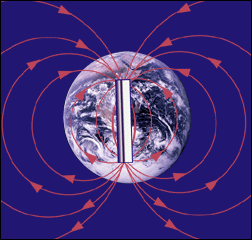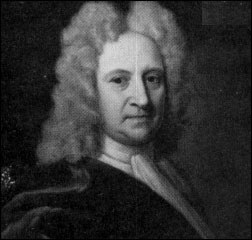Today magnets can be found in almost every home: refrigerator magnets, compasses, screwdrivers, cow magnets, bar magnets, and hard drives in computers. Long ago, compasses were the only commonly used magnets. Compasses helped guide travelers because the needle on a compass would always point north. People used compasses long before anyone knew that a compass was magnetic, and long before anyone knew about magnetism.
 In the late 1500's, William Gilbert realized that the compass was a tiny magnet and it was interacting with a larger magnetic field in order to point north. In 1600, he published "De Magnete" explaining that "the globe of the earth is magnetic, a magnet," Chapter 17, Book 1.
In the late 1500's, William Gilbert realized that the compass was a tiny magnet and it was interacting with a larger magnetic field in order to point north. In 1600, he published "De Magnete" explaining that "the globe of the earth is magnetic, a magnet," Chapter 17, Book 1.
If you take two bar magnets and play with them for a while, you will realize that each end of the bar magnet will either repel or attract one end of the other bar magnet. Each end of a bar magnet is called a magnetic pole with one end as a north pole and one as a south pole. Like poles (e.g. south-south) repel, and opposite poles (e.g. south-north) attract. Because the bar magnet has two poles, its magnetic field is called a dipole magnetic field. It appears that all magnetic fields have an even number of poles, as scientists have been looking for a single magnetic pole for over 50 years now but have never found one.
Meanwhile, Shun-ichi Akasofu began looking more closely at the All-Sky camera data. He writes (on page 17):
 Relatively close to Earth (out to about 8 Earth Radii or 50,000 km at the Equator), Earth's magnetic field looks approximately like that of a bar magnet, as shown in the figure. There are some strange places on Earth that make the dipole different that in the picture. And if we go further out into space, Earth's magnetic field gets weaker and is affected by charged particles in space. We will talk more about this in the Sun-Earth Connection page. We call Earth's magnetic field and the particles and space within this field, Earth's "magnetosphere."
Relatively close to Earth (out to about 8 Earth Radii or 50,000 km at the Equator), Earth's magnetic field looks approximately like that of a bar magnet, as shown in the figure. There are some strange places on Earth that make the dipole different that in the picture. And if we go further out into space, Earth's magnetic field gets weaker and is affected by charged particles in space. We will talk more about this in the Sun-Earth Connection page. We call Earth's magnetic field and the particles and space within this field, Earth's "magnetosphere."
Why are we talking about magnetic fields? These pages are about the aurora and auroral substorms! Yes, but Earth's magnetosphere plays a very important role in the aurora and in auroral substorms.
If you would like to measure magnetic fields around different magnets, here is an activity
(Measuring Magnetism - ![]() PDF Format - 180kb) that shows you how!
PDF Format - 180kb) that shows you how!



